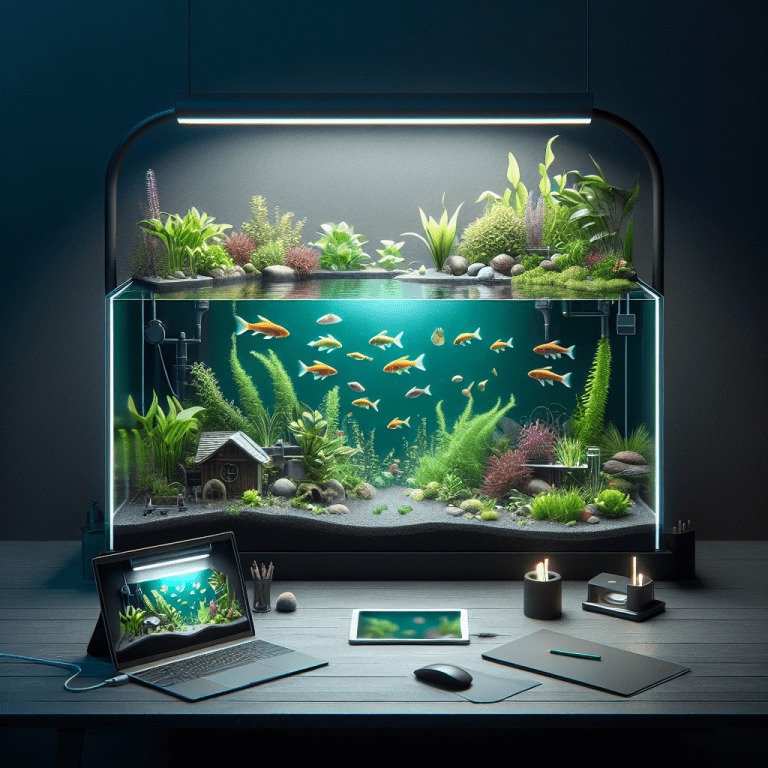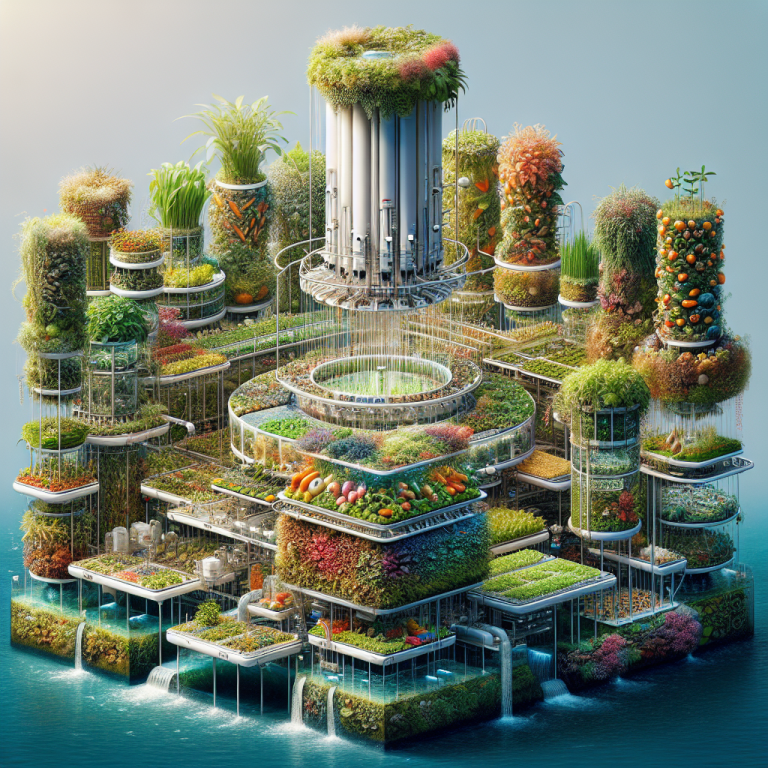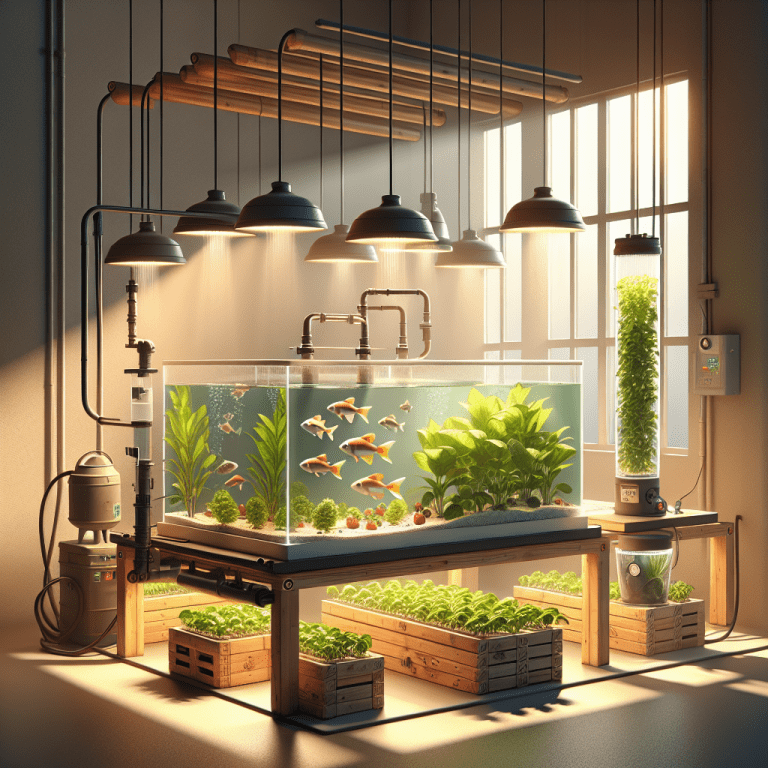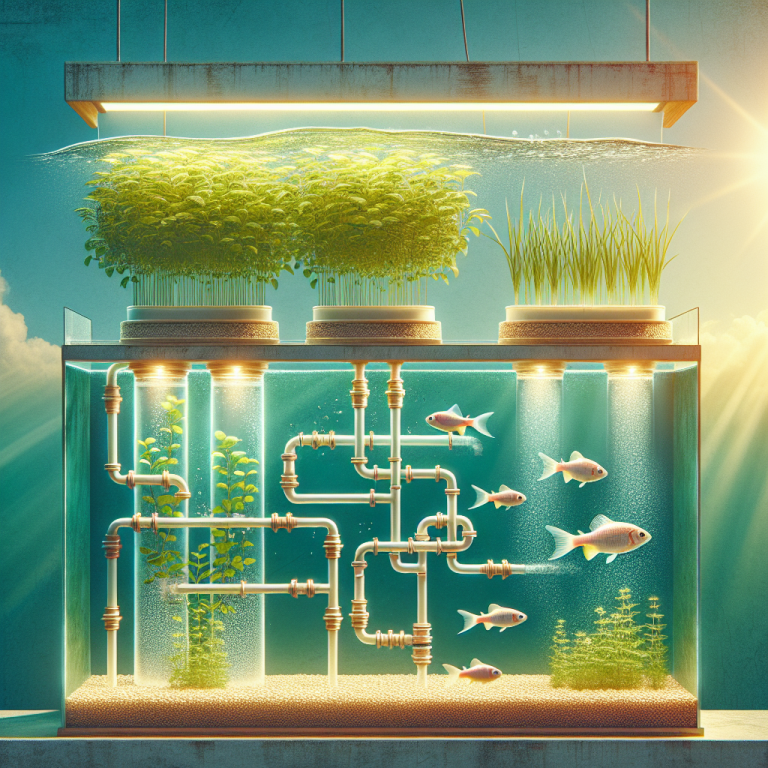Hello, fellow earth-lover! Let’s take a moment to imagine, shall we? Picture fresh, lush greens paired with healthy, shiny fish. Sounds like a perfect meal, right? But what if instead of the grocery store, it came from your own backyard? Yup, you read that right! We’re talking about "Sustainable Aquaponics Practices", a mouthful of words that could change your world.
No need to feel clueless or intimidated, we were all beginners once! I remember that initial bewilderment, not knowing where to start or what fish and plants were ideal. Or the panic when the water got murky. And the challenge of dealing with unanticipated pest attacks. Oof, brings back memories!
But fear not, clarity awaits you. We’ve brewed our own struggles and trials into this simple, comprehensive guide. We trust it’ll be your torchlight in the sometimes foggy journey of setting up an aquaponics system. We'll journey through selecting the best fish and plants, maintaining water quality, and harvesting the fruits (and fish) of your labor. Sneaky problems popping up? We've got you covered on troubleshooting too!
A heads up – no magic beans or instant fixes here. But we do promise new learning, fun challenges, and a system you can scale. With a dash of creativity and a good dose of enthusiasm, get ready to nurture life and sustainability, literally in your own backyard. Now, aren't you excited? Let’s get started!
Understanding Sustainable Aquaponics Practices
can be as easy as tending your own garden. Or even tending to a fish tank. Imagine marrying the two. That's essentially the magic of aquaponics. It’s about raising plants and fish together, creating an eco-friendly cycle. How so?
Let’s break it down for you. The fish in their tank produce waste. Hard to believe, right? But here's where it gets interesting – this fish waste (termed politely as effluents) ticks off the nutrients box for plants. The plants, needing no invitation, lap these nutrients up. As they do so, they purify the water for the fish. It’s like housemates making agreements on chores: "You take out the trash, I’ll do the dishes".
And in this setup, like knowing which housemate prefer early days or night owl schedule, you're in control. You dictate the conditions: from choice of fish to types of plants. That’s just what sustainable aquaponics is. A customizable, compact, and – just between us – quite a remarkable eco-system at play.
Now you know what ‘fish effluents to nutrients’ mean. It's no longer alien. And that's the first trick to mastering sustainable aquaponics practices. Carry these lessons with us further, into the rest of the guide. It’s not as scary as it first seemed, right?
Setting Up Your Aquaponics System
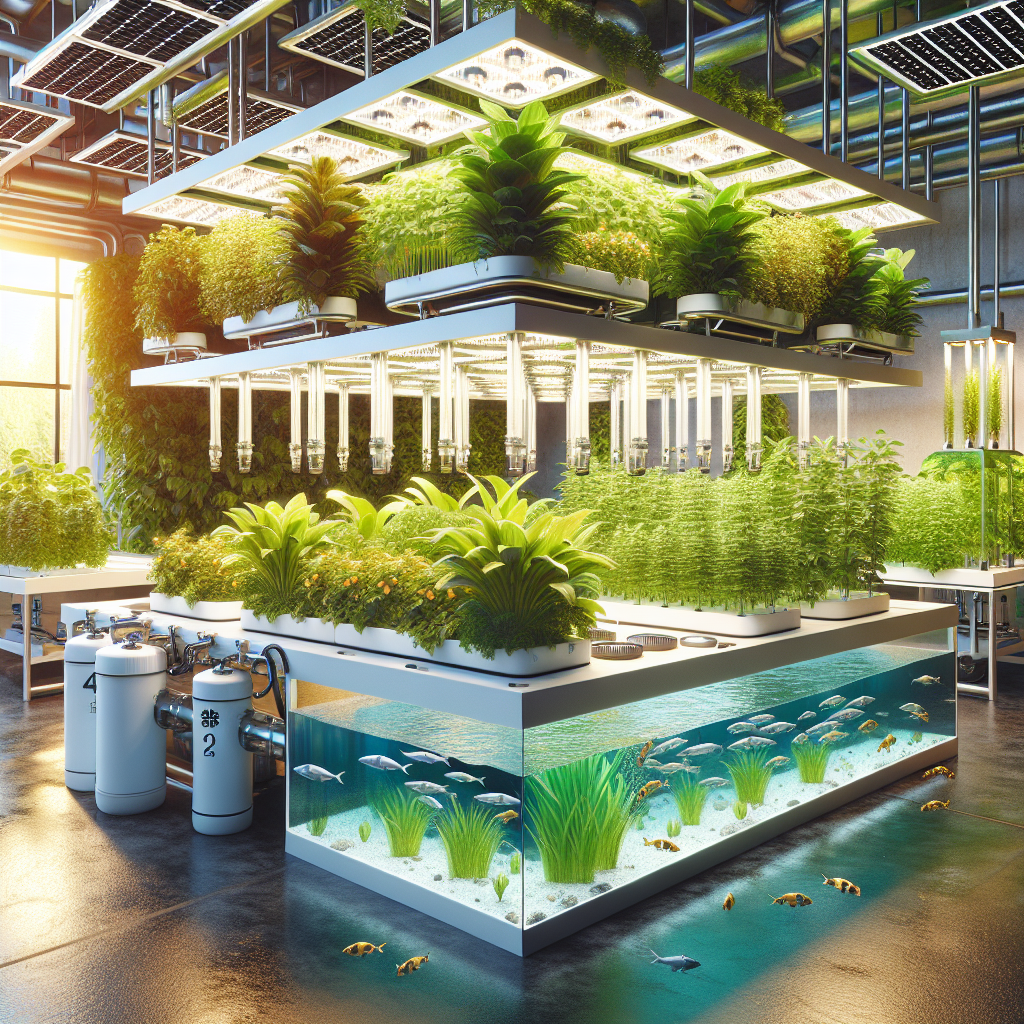
Navigating sustainable aquaponics practices might seem daunting from the get-go. Don't be dismayed; establishing an ecosystem is an engaging adventure! And not to worry. You may lack experience, but passion is a sturdy foundation.
Let's start simple. Your aquaponics setup breathes life from two primary components. Fish and plants. They form a cycle—fish produce waste which nourishes the crops. The crops, in turn, purify the water for aquatic life. It's eco-friendly teamwork!
Consider a compact aquarium as a starter. Ever seen a guppy in florescent lighting? Absolutely mesmerizing. Equally important, get to know your leafy companions. For adulting points, opt for nutrient-dense varieties like kale, spinach or chard.
Remember to closely monitor your nitrogen levels to ensure ideal conditions. Fish waste becomes ammonia, novel plant food. Here's where biology plays matchmaker! Friendly bacteria convert that ammonia into usable nutrients for your plants. Clever, aren't they?
For a sustainable touch, consider solar-powered equipment. Light up your system and sustain its temperature using clean, renewable energy!
And there you go — a beginner's crash course in equitable, sustainable aquaponics practices! Feels achievable, doesn't it? Just visualize your first mouthful of self-grown greens. Smug satisfaction guaranteed. So, buckle up for sustainable gastronomy! Tomorrow, we'll dive deeper into choosing your first fish and plant pals. Self-sufficiency is just a few steps away, my friend!
Choosing the Right Fish and Plants
Building on the insights shared earlier, you might ask, "how do I pick the right elements for an aquaponics system?" Ironically, it's much like deciding which plants to grow on your home garden porch or what type of fish to get for your own aquarium, except you are aligning these in harmony as part of sustainable aquaponics practices.
Better yet, picture yourself at a seafood buffet. There are heaps of crab meat, rows of shrimps, and piles of fresh salmon, but your plate is small. You’ve got to find what complements your diet and fits within the available space. Aquaponics is in a way, like that. Go for a synergistic combination of fish and plants that could survive together. Plus, it's an excellent opportunity to grow food you love!
Goldfish could be an approachable pick for the fish-side. Why? They're hardy, hence a great choice for beginner's precious mistakes. For vegetables, pick leafy plants. Let's imagine crisp lettuce, hearty kale. They also thrive pretty well in an aquaponic system. Bring in your creative aspect here, mix, match, and experiment.
Opting for sustainable aquaponics practices means not only raising your own food sustainably but also contributing to the planet's well-being. Picture walking out to your garden to pick fresh, organic veggies, knowing it's helping Mother Earth breathe a little easier. Sounds fantastic, right? That’s your cue. Go ahead, dive in!
Maintaining Water Quality
Moving forward in our exciting exploration of sustainable aquaponics practices, let's delve into a crucial aspect: maintaining water quality. Picture your beautiful aquaponics setup. All the plants are thriving. But what about the unseen element that plays a considerable role in the system’s balance? Yes, you guessed it. The water.
Aquaponics and fabulous water quality are inextricably linked like great friends. Heaven-like water forms when the waste from fishes works as a natural fertilizer for plants. At the same time, the plants clean water for fish like a dream come true for both, isn't it? This natural cycle is what sustainable aquaponics practices are all about.
By testing water regularly, you ensure clarity and balance in your system. Look out for factors such as pH, ammonia, nitrite, and nitrate levels. Think of it as looking in your fridge. Just as there's an ideal temperature range to keep your food nice and fresh, in your aquaponics system, optimal ranges maintain good health.
Here's an example. If the pH strays too far from the ideal range, you'll notice your lettuce leaves turning a funky yellow. A simple titration kit can bring you quick results. It's pretty easy to use and a great tool for making this sustainable practice a regular part of your life.
Be persistent in your observation, guys! Even minor fluctuations matter in your little ecosystem. Coping with those mishaps early ensures your system stays strong and vivacious. Enjoy the thrill of implementing these sustainable aquaponics practices. The rewards? healthy harvests, sparkling water, and ultimate satisfaction. It's worth it all!
Monitoring Growth and Harvesting
Expanding on our previous discussion, let's dive into how you can successfully implement your sustainable aquaponics practices while monitoring growth and harvesting.
The first step is being attentive. Keep an eye on your fish and plants. Any changes in color can indicate good or bad health. If you notice anything upsides of the norms, do some research or ask a seasoned aquaponics gardener. You know that mate from the community garden? Yes, their wisdom just might save your crops!
Next, practice patience. I mean, haven't we learned that good things come to those who wait? Keep your expectations under check and remember that rapid growth is not always healthier. Sustainable Aquaponics is all about encouraging natural, measured growth.
Monitoring is crucial but so is harvesting. Harvesting at the right stage directly affects the taste and nutrient content. Unlike those crazy Black Friday sales, there's no use rushing!
Examples? It's like picking an apple when it's still green versus ripe. The taste, texture, and even vitamin content can vary significantly. So exercise patience here too. Well, Rome wasn't built in a day, was it?
Remember, the aim here is transformation, not winning a sprint race. With sustainable aquaponics practices, you get nutritious food and participate in reducing environmental impacts. Healthy living while saving the planet? Sounds like a win-win to me. So take the plunge and embrace this journey.
Troubleshooting Common Issues
So, you've started your sustainable aquaponics journey. It's exciting stuff, but like bringing home a new pet, it might come with a few—okay, several—challenges. Sustainable practice is key, as we discuss throughout this guide. However, beginners often stumble.
Picture this possible scenario: Your plants aren't growing as fast as you'd like, perhaps. Or your fish look less content than usual. Don't start panicking just yet! Seasoned practitioners have been there and survived—in fact, they're now thriving thanks to their experience.
Using sustainable aquaponics practices is a journey of knowledge—not all smooth sailing, sure—but overwhelmingly rewarding. All you need to do is keep calm and carry a suitable action plan.
Be proactive. Regularly test your system's water for the right chemical balance. Also, ensure the fish have enough food and oxygen, while maintaining ideal water conditions. It's customary for beginners to learn as they go.
If it so happens the issue persists, consider reaching out to a more experienced practitioner. They're a rich source of information when it comes to these practices. Connecting with common folk who’ve walked this path successfully can be incredibly reassuring.
That’s just a taste; combating common issues in a sustainable way is possible. With foresight, patience, and commitment—you've got this!
Scaling Up Your Aquaponics System
Carrying these lessons with us, let's dive into multicellular life in aquaponics. Exciting, right? Consider how a goldfish scales to be many times its size in a swallowed universe-like tank. It's similar with sustainable aquaponics practices. You need a deeper tank and wider beds for your system to grow.
Begin by looking at your fish tank. Think: Can it govern the 'wolf pack' of fish comfortably even if they grow a little bigger? Remember, no cramping –we’re all about animal wellbeing here.
What about your grow beds? These are places for the plants to grow. Are they spread out enough for more plants if say, you met a chia seed on the street and decided to grow it? Kidding aside, up the grow beds proportionally. An expert tip is to aim for a 1:1 ratio between the fish tank and the grow beds.
Sounds technical, don't fret. Let’s put it in real terms. Think of the tank as your house. The grow beds? They're your garden space. Placing a heavy focus on equitable sustainable aquaponics shows your commitment to embracing innovation and creativity.
Feel the power yet of owning your own ecosystem? Easy layers of interaction that net you both fish and greens! Amazing what you can achieve with just learning a bit of aquaponics magic.
We've come a long way, haven't we? Unraveling the in-depth realm of sustainable aquaponics practices together. Every exciting bit, from selecting the ideal neighborhood for your finned buddies to reaping your organic produce, has been deeply hefty. And surely, you've learned that becoming Mother Nature's helping hand isn't as overwhelming as previously perceived!
This comprehensive guide has served as a roadmap to kickstart your journey towards healthier living. With each step, you've taken an enthusiastic dive into an innovative world brimming with greener scenarios. Now, with the acquired knowledge, you stand at the threshold of an exciting endeavor that deftly weaves environmental consciousness with health and wellness benefits.
Stepping into the shoes of an aquaponics farmer might seem daunting at first glance. Remember, though, even the best gardeners began with the first sow. And in this thoroughly modern take on traditional agriculture, there's plenty of room for innovation and growth, for both the plants as well as for your greening thumb!
The understanding accumulated now breathes in confidence for diving into this harmonious symbiosis of aquaculture and agriculture. Will there be challenges? Unavoidably yes. But with grit and creativity, triumph is inevitable, just as growth after planting a seed. So, why hesitate?
Ready for a healthier lifestyle through a seamless eco-loop? Begin your epic journey today. Embrace sustainable aquaponics, and watch as the fruits (or veggies) of your labor bloom! There's no time like the present to start proving your green thumb. Happy Farming!
